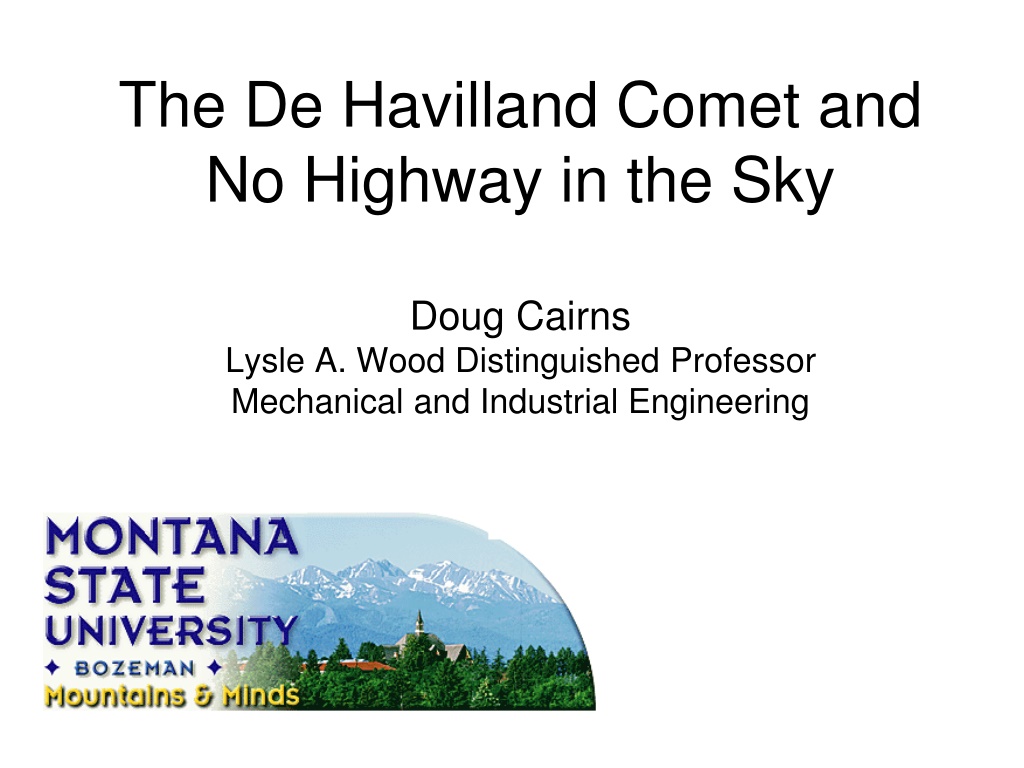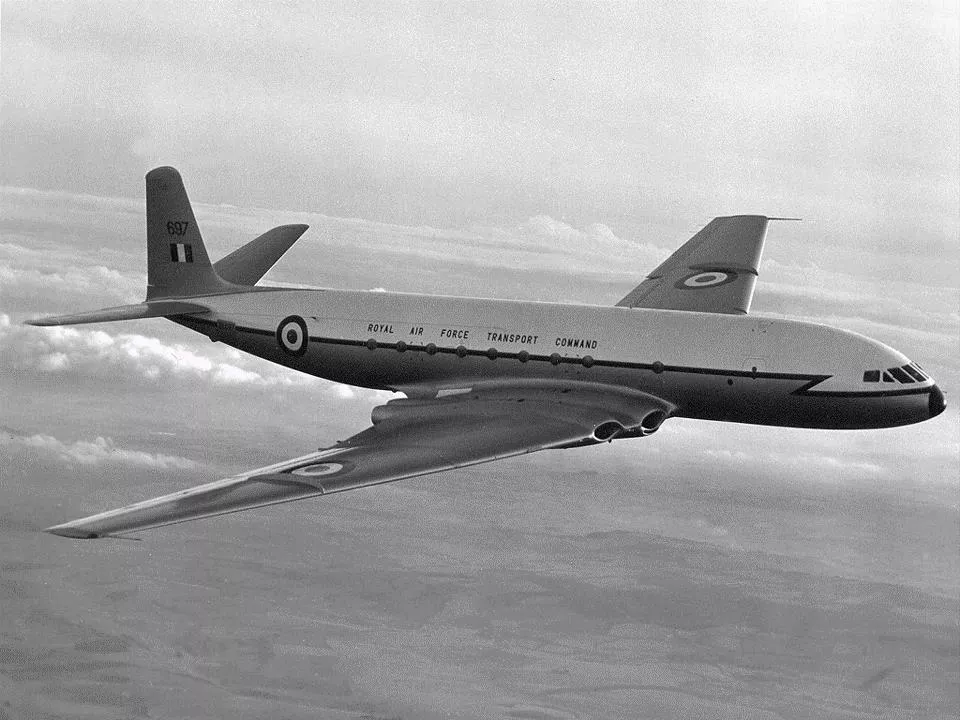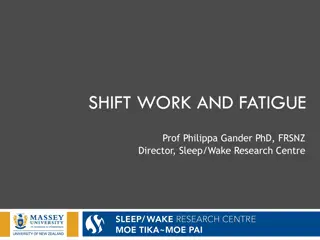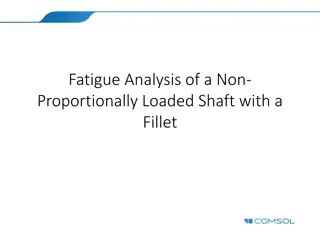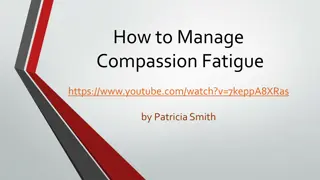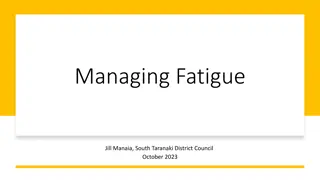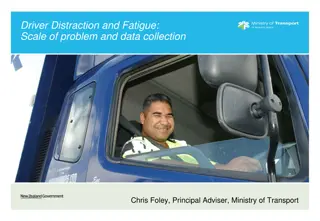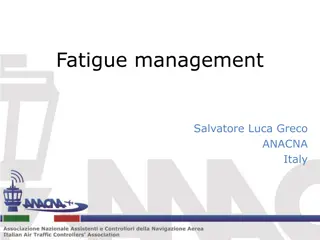The De Havilland Comet - Pioneering Aircraft and Metal Fatigue
The De Havilland Comet, the world's first jetliner, revolutionized aviation but faced tragic early hull losses due to metal fatigue, a concept highlighted by novelist Nevil Shute in "No Highway." The aircraft's legacy and impact on engineering are profound.
Download Presentation

Please find below an Image/Link to download the presentation.
The content on the website is provided AS IS for your information and personal use only. It may not be sold, licensed, or shared on other websites without obtaining consent from the author. Download presentation by click this link. If you encounter any issues during the download, it is possible that the publisher has removed the file from their server.
E N D
Presentation Transcript
The De Havilland Comet and No Highway in the Sky Doug Cairns Lysle A. Wood Distinguished Professor Mechanical and Industrial Engineering
The De Havilland Comet The World s First Jetliner
The De Havilland Comet BOAC British Overseas Airways Corporation Now British Airways
The De Havilland Comet Comet 1 4 (2 pilots, flight engineer and radio operator/navigator)[182] 36 44[16] 36 44[138] 96 ft 1 in (29.29 m)[136]111 ft 6 in Comet 2 Comet 3 Comet 4 Cockpit crew Passengers 58 76[142] 56 81[183] 111 ft 6 in (33.99 m)[184] Length 93 ft (28 m)[136] (33.99 m)[142] Wingspan Tail height 115 ft (35 m)[184][185] 29 ft 6 in (8.99 m)[184] 2,015 sq ft (187.2 m2)[136] NACA 63A116 mod root, NACA 63A112 mod tip[186] 110,000 lb (50,000 kg)[136] (54,000 kg)[136] 2,015 sq ft (187.2 m2)[136] 2,015 sq ft (187.2 m2)[136] 2,121 sq ft (197.0 m2)[184] Wing area Airfoil Maximum takeoff weight (MTOW) 120,000 lb 150,000 lb (68,000 kg)[136] 156,000 lb (71,000 kg)[184] Operating range (typical performance) 1,500 mi (1,300 nmi; 2,400 km)[69] 2,600 mi (2,300 nmi; 4,200 km)[185] 2,700 mi (2,300 nmi; 4,300 km)[187] 3,225 mi (2,802 nmi; 5,190 km)[182] 740 km/h (400 kn; 460 mph)[136] 42,000 ft (13,000 m)[136] 790 km/h (430 kn; 490 mph)[185] 42,000 ft (13,000 m)[185] Rolls-Royce Avon Mk 503/504 turbojets: 7,000 lbf (31,000 N)[136] 840 km/h (450 kn; 520 mph)[185] 45,000 ft (14,000 m)[185] Rolls-Royce Avon Mk 502/521 turbojets: 10,000 lbf (44,000 N)[142] 840 km/h (450 kn; 520 mph)[188] 42,000 ft (13,000 m)[182] Cruising speed Cruise altitude Halford H.2 Ghost 50 turbojets: 5,000 lbf (22,000 N)[136] Rolls-Royce Avon Mk 524 turbojets: 10,500 lbf (47,000 N Powerplants (x 4)
Early Hull Losses 1952 1953 1954 (2) Early hull losses blamed on pilot error or weather Investigations and re-designs allowed Boeing 707 to enter the market .the rest is history.
Metal Fatigue Metals get tired odd but true. It is called metal fatigue and is the reason why even a child can break a steel coat hanger with little difficulty: the back and forth motion induces small changes in the microstructure cracks leading to catastrophic failure. The work was largely ignored by engineers but not by the novelist Nevil Shute, who wrote No Highway in 1948 about an aircraft disaster caused by metal fatigue; the subsequent film starred Jimmy Stewart. A few years later, reality caught up with fiction when the Comet aircraft did actually start to fall out of the sky, and it was only then that the science was taken seriously. (First published by Griffith in 1921.)
The De Havilland Comet High Strength, Low Fatigue Life Aluminum
Neville Shutes No Highway in the Sky
Nevil Shutes No Highway in the Sky Prediction to Comet Disaster Coincidence? (You Decide) Nevil Shute worked and was accomplished British aerospace engineer Comet Reindeer (the name of the aircraft model in the movie) Nevil Shute s other books On the Beach (the end of humanity from nuclear war) A Town Like Alice (about Alice Springs, Australia) No Highway in the Sky was required viewing for all engineers working in Damage Tolerance for the FAA
Commercial Jet Fleet Safety Record Structural Reliability is a Given; One cannot argue with the results Structural Failures are now VERY RARE; Don t Let this Movie Scare You.
